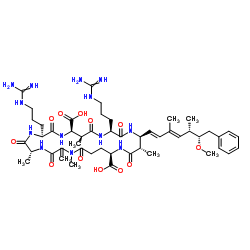Removal of a potent cyanobacterial hepatotoxin by peat.
M Sathishkumar, S Pavagadhi, A Mahadevan, R Balasubramanian, D F Burger
Index: J. Environ. Sci. Health. A. Tox. Hazard. Subst. Environ. Eng. 45(14) , 1877-84, (2010)
Full Text: HTML
Abstract
Microcystins (cyclic heptapeptides), produced by a number of freshwater cyanobacteria, are of health concern in potable water supplies. In this article, the adsorptive removal of microcystin-RR (MCRR) from the aqueous solution by a low-cost adsorbent, peat, was investigated. The BET surface area of peat was found to be 12.134 m2/g. The adsorption process was pH dependent, with maximum adsorption occurring at pH 3. Kinetic studies revealed that the adsorption of MCRR onto peat was a rapid process. The adsorption capacity (Qmax) as revealed by the Langmuir model was found to be 286 μg/g at pH 3. Among various desorption media studied, strong alkali solutions (2 N NaOH) showed the highest desorption (97%). Thus, peat has potential to be used as an adsorbent for the removal of the cyanotoxin, MCRR, from drinking water.
Related Compounds
| Structure | Name/CAS No. | Molecular Formula | Articles |
|---|---|---|---|
 |
Microcystin RR
CAS:111755-37-4 |
C49H75N13O12 |
|
The conjugation of microcystin-RR by human recombinant GSTs ...
2013-06-07 [Toxicol. Lett. 219(3) , 231-8, (2013)] |
|
Similar uptake profiles of microcystin-LR and -RR in an in v...
2011-11-28 [Toxicology 290(1) , 7-13, (2011)] |
|
In vitro and in vivo safety assessment of edible blue-green ...
2011-07-01 [Food Chem. Toxicol. 49(7) , 1560-4, (2011)] |
|
Antioxidant response in liver of the phytoplanktivorous bigh...
2010-06-01 [Fish Physiol. Biochem. 36(2) , 165-72, (2010)] |
|
The apoptotic effect of oral administration of microcystin-R...
2011-10-01 [Environ. Toxicol. 26(5) , 443-52, (2011)] |